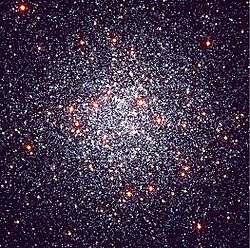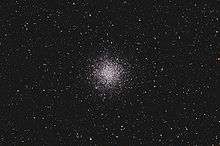Messier 55
| Messier 55 | |
|---|---|
 | |
| Observation data (J2000 epoch) | |
| Class | XI[1] |
| Constellation | Sagittarius |
| Right ascension | 19h 39m 59.71s[2] |
| Declination | −30° 57′ 53.1″[2] |
| Distance | 17.6 kly (5.4 kpc)[3] |
| Apparent magnitude (V) | +7.42[4] |
| Apparent dimensions (V) | 19′.0 |
| Physical characteristics | |
| Mass | 2.69×105[3] M☉ |
| Radius | 48 ly[5] |
| Metallicity | = –1.94[3] dex |
| Estimated age | 12.3 Gyr[6] |
| Other designations | M55, NGC 6809, GCl 113, C 1936-310[4] |


Messier 55 (also known as M55 or NGC 6809) is a globular cluster in the constellation Sagittarius. It was discovered by Nicolas Louis de Lacaille in June 16, 1752 while observing from what today is South Africa.[7] Starting in 1754, Charles Messier made several attempts to find this object from Paris, France, but the low declination meant it never rose sufficiently far above the horizon to allow for easy observation. He finally observed and catalogued it in 1778. The cluster can be seen with a pair of 50 mm binoculars, although resolving the individual stars requires a medium-sized telescope.[7]
M55 is at a distance of about 17,600 light-years away from Earth. It has a mass of about 269,000 times that of the Sun.[3] As with other Milky Way globular clusters, it has a low abundance of elements other than hydrogen and helium compared to the Sun—what astronomers term the metallicity of the cluster. This quantity is normally listed as the base–10 logarithm of the proportion relative to the Sun; for NGC 6809 the metallicity is given by: [Fe/H] = –1.94 dex.[3] Taking this exponent to the powers of 10 yields an abundance equal to 1.1% of the proportion of such elements in the Sun.
Only about 55 variable stars have been discovered in the central part of M55.[8]
References
- ↑ Shapley, Harlow; Sawyer, Helen B. (August 1927), "A Classification of Globular Clusters", Harvard College Observatory Bulletin (849): 11–14, Bibcode:1927BHarO.849...11S.
- 1 2 Goldsbury, Ryan; et al. (December 2010), "The ACS Survey of Galactic Globular Clusters. X. New Determinations of Centers for 65 Clusters", The Astronomical Journal, 140 (6): 1830–1837, Bibcode:2010AJ....140.1830G, arXiv:1008.2755
 , doi:10.1088/0004-6256/140/6/1830
, doi:10.1088/0004-6256/140/6/1830 - 1 2 3 4 5 Boyles, J.; et al. (November 2011), "Young Radio Pulsars in Galactic Globular Clusters", The Astrophysical Journal, 742 (1): 51, Bibcode:2011ApJ...742...51B, arXiv:1108.4402
 , doi:10.1088/0004-637X/742/1/51
, doi:10.1088/0004-637X/742/1/51 - 1 2 "NGC 6809", SIMBAD Astronomical Database, retrieved 2006-11-16
- ↑ distance × sin( diameter_angle / 2 ) = 48 ly. radius
- ↑ Sollima, A.; et al. (April 2008), "The correlation between blue straggler and binary fractions in the core of Galactic globular clusters", Astronomy and Astrophysics, 481 (3): 701–704, Bibcode:2008A&A...481..701S, arXiv:0801.4511
 , doi:10.1051/0004-6361:20079082
, doi:10.1051/0004-6361:20079082 - 1 2 Thompson, Robert Bruce; Thompson, Barbara Fritchman (2007), Illustrated guide to astronomical wonders, DIY science, O'Reilly Media, Inc., p. 413, ISBN 0-596-52685-7
- ↑ Kaluzny, J.; et al. (September 2010), "The Cluster AgeS Experiment (CASE). Variable Stars in the Globular Cluster M55", Acta Astronomica, 60 (3): 245–260, Bibcode:2010AcA....60..245K, arXiv:1011.0831

External links
| Wikimedia Commons has media related to Messier 55. |
- Messier 55, SEDS Messier pages
- Messier 55, Galactic Globular Clusters Database page
- Messier 55 on WikiSky: DSS2, SDSS, GALEX, IRAS, Hydrogen α, X-Ray, Astrophoto, Sky Map, Articles and images
Coordinates: ![]() 19h 39m 59.40s, −30° 57′ 43.5″
19h 39m 59.40s, −30° 57′ 43.5″
